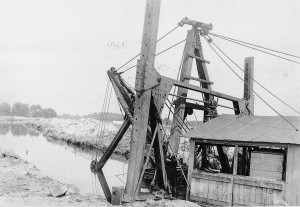True Tales: Our river through the meadows
By George T. ComeauThe river we see today is not the same river that was used by the prehistoric or colonial people. In 1911, the legislature was pressed to act by allowing the dredging and straightening of the river. The Fowl Meadows had become “foul.” The stench and disease (most notably malaria) was dreadful. The legislature ordered the river to be repaired of these nuisances. The dredging operation began in 1913 and would widen and deepen the river. The refuse from the muck was merely deposited on the banks, and by 1923 complaints abounded from the landowners whose once fertile fields would now no longer drain properly. The straightening also bypassed the “horseshoe” curve in the river, which abutted Horseshoe Swamp. Even today the boundary line with Norwood follows the old course of the river and Horseshoe Meadow remains in Canton.

Dredging of the Neponset River in Canton, 1913. (Photo by I. Chester Horton, courtesy of the Canton Historical Society)
In the 1960s the river was once again polluted and described as a “noxious mess.” A canoe trip in August 1966 from Canton was described in the Patriot Ledger as follows: “The moment we set our canoes into the putrid, murky water on Neponset Street we were overwhelmed by the noxious odor caused by the industrial waste dumped into the river by the various firms along its banks. Globs of sludge floated past us in the water.” So polluted was the trip that day, the canoes were forced to turn back — great globs of paper and raw sewage made the trip unbearable. This was a turning point for the Neponset. Once again the legislature took up the reclaiming of the Neponset River. In 1974, a bond bill was filed to begin the process of creating improvements to the damaged waterway.
At the lead of the conservation efforts was the Neponset Conservation Association. Founded in 1965, their mission continues today as the Neponset River Watershed Association. With over 700 members, hundreds of volunteers and a staff of three full-time and four part-time employees, this is the future of the Neponset River. For over 45 years this group has been responsible for raising the public awareness of our great river. The advocacy continues — just last week the legislature’s Environment Committee held a hearing on the Sustainable Water Resources Act. This act will hopefully set the process by which the Department of Environmental Protection, with the cooperation of the Department of Fish and Game, will set the definition for the amount of water that makes rivers sustainable.
In 2008 a member of the Massachusett-Ponkapoag Tribal Council testified at a public meeting organized to discuss the future of the Neponset River. I leave you with his sage words: “The Neponset people, and there were Neponset people, were forced to leave the Neponset River because those persons who came later decided there was a better use for the Neponset River than our use, which contributed to the well-being of our universe and yours for centuries. Now I’m going to speak for the elders — I’m going to speak for the finned, the furred, the winged, and the ancestors, mine and yours. These are the voices you are not listening to. Put the river back the way it was. Allow the herring to come back and sing their song.”
To visit Signal Hill, take Dedham Street and immediately after crossing I-95 and railroad bridges, take a left on University Road. Proceed through the office park. Parking is on the right just before the last building, also on the right. Free and open year-round, sunrise to sunset. Allow a minimum of one hour.
Page 1 Page 2
Short URL: https://www.thecantoncitizen.com/?p=6774










